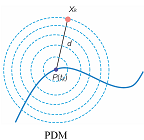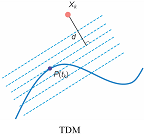|
| |
|
SDM
(Squared Distance Minimization) was originally proposed by Pottmann et al
[Pottmann et al. 2003]. It is
an iterative optimization scheme for approximating a target shape with
a piecewise smooth curve or surface, such as a B-spline curve or
surface, or a subdivision surface.
SDM
has superior performance in both convergence and stability over
PDM
(Point Distance Minimization)
and
TDM
(Tangent Distance Minimization).
|
|
|
|
|

|
|
PDM
uses the
PD
error term, which measures the squared distance between the data point
X
k
and a particular point
P
(
t
k
) on the fitting curve, i.e.
|

|
|
|
|

|
|
TDM
uses the
TD
error term, which measures the squared distance from
X
k
to the tangent of the fitting curve at
P
(
t
k
), i.e.
|

|
|
|
|

|
|
SDM
uses the
SD
error term, which is the local quadratic approximant of the squared distance from the sample point
P
k
to the target curve
C
, i.e.
|

|
|
|

